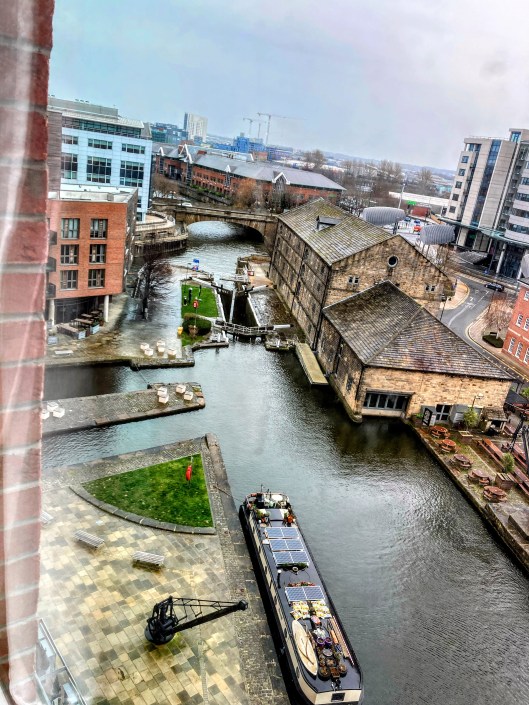Tags
covid, England, folly, Fountains Abbey, Harewood House, history, humor, Leeds, lockdown, National Trust, wedding, World Heritage Site, writing
I finally get Tale of Two Cities
Back in the dim recesses of years dated BC (Before Covid), my high school English teacher assigned Charles Dickens’ A Tale of Two Cities. A few weeks later, there was a pop quiz. Except for my younger sister/classmate, the entire class failed the quiz. (My sister later admitted that her expertise was from watching the old movie, which was the only thing on TV while she was babysitting the week before.) I remember Lisa Dougherty standing up and telling the teacher the book was so dry that if Noah was navigating the ark across a flooded world today, the dove would bring back A Tale of Two Cities.
Our unimpressed teacher sentenced us to read the entire book aloud during lunch detention—for the rest of our natural lives, I think, as that dessicated book was well over a bazillion pages. Luckily, my parents took pity on us and we moved to another state.
From that torture, I remember two things. First is my sister, who was assigned to read the part of Little Lucy Manette (which she did with movie-Lucy’s cringe-worthy handwringing and call of, “Eeeeauoh pray faaaaah-thaaaa.”) And second was the phrase, “Recalled to Life”, the code for old Dr. Manette’s return to society after years of enforced isolation. But Dr. M wasn’t buying it. And now that we’re supposed to come out of our covid restrictions/quarantine/isolation, I’m understanding his misgivings.
For the first time in all these years, I get Dr. Manette’s reluctance to emerge from captivity.
The Save-the-Date had been on my fridge for two years.
Every now and then I wondered about that covid-postponed wedding. Then the bride’s mother anxiously emailed, “… if you can get off the bloody island we are hoping you are coming!” Seems my invitation had gone awol and the wedding was ON. (She knows me well, so she informed me that I WOULD be wearing a dress. And makeup. And I would get myself to Leeds asap, and I would like it. Well, damn.)
When Leeds was originally chartered in the early 13th century, town fathers shortsightedly failed to plan for a future that included the automobile. Navigating the spaghetti-tangle of streets to reach my hotel on the old Granary Wharf was…challenging. Much cursing happened, even though I now drive British (smile and give the British-wave to allow other drivers to go ahead of you, something Americans would see as threat to their street cred, manhood, and proof of life.)
Our first stop was Harewood House. Although the house itself (which starred as Downton Abbey in the recent film) wasn’t open to visitors, our real goal was the garden. A proper English garden in the mid-18th century required a water feature and an architectural feature such as a ruin (usually man-made) or folly. Harewood House offered both.

Designed by Lancelot “Capability” Brown, the most famous landscape designer of the era, the gardens surrounding Harewood House also include a collection of exotic birds and even penguins. (Penguins!)

The wedding was the best I’ve attended in years. (Okay, it’s probably the only one I’ve attended in years, but any wedding that has homemade Sloe Gin and personalized M&Ms as favors instead of dental-hazard Jordan Almonds is a winner.)
The next morning, grey clouds threatened. Rain was obviously imminent. But I’d already tasted freedom, so I pointed my little car north to Fountains Abbey, a National Trust and World Heritage site.
By the time John Aislabie inherited in 1693, the Studley Royal estate had already been in the family for over 200 years. But John wanted more. LOTS more. One of the architects of perhaps the largest financial swindle in British history, the South Sea Bubble, Aislabie retired to his estate politically disgraced but swimming in profits. What his estate needed, he decided, was two things: a water feature, and a folly. On steroids.
The water feature was miles of lake, shaped to gently highlight temples, classical statues, waterfalls, and gardens.
The folly had to be on equally epic scale. Luckily, the very thing was just next door.
Fountains Abbey was founded in 1132 by thirteen monks who joined the Cistercian Order in search of a simpler, more devout life—and those all-important lay brothers to take care of all that pesky day-to-day labor. Soon the new Cistercian Abbey became one of the largest in England, welding enormous wealth and power, with crops and wool from tens of thousands sheep on their vast acreage.
They survived marauding Scots, bad harvests, and the Black Death. Unfortunately for the monks, King Henry VIII had the hots for Anne Boleyn, and since the Pope refused to annul his (23-year) marriage to Catherine of Aragon, Henry started his own church. As one does.

I’m sure the fact that English religious houses controlled more than 25% of the wealth of England had absolutely nothing to do with the Dissolution of the Monasteries act that removed Fountains Abbey roofs in 1539, leaving the massive abbey in ruins overnight.
It sucked for the monks, but two hundred years later, it made the perfect garden ornament for the Aislabies.
Best. Folly. Ever! But John Aislabie’s dream didn’t become reality until his son William inherited and managed to buy the abbey property. Although the Studley Royal house itself was destroyed by fire in 1946, the incredible water gardens and largest monastic ruins in England are still breathtaking.
But bring your wellies, and be ready to walk miles.










I love every bit of this and what a wonderful wedding!
LikeLiked by 2 people
It was all a wonderful weekend, and a perfect reintroduction to real life. SO fun!
LikeLiked by 2 people
Wow, gorgeous!
LikeLiked by 2 people
I know, right? You would have LOVED it. Especially St. Mary’s, the incredible little church on the grounds that I didn’t even have time to include here. [photo from Wikimedia Commons]

LikeLiked by 3 people
It looks incredible! I do love old churches!!
LikeLiked by 2 people
Looks like a great place for a long walk!
LikeLiked by 2 people
Soooooo long! I’m in line for back surgery, so I knew I shouldn’t attempt it. But… how could I resist? And 5 miles wouldn’t kill me, right? (When I got up the next morning, I wasn’t so sure.) But if there’s anything I’ve learned from the past two years of life on hold, it’s that you have to go for opportunities when they present, rather than depend on getting the chance again in an increasingly dubious future.
LikeLiked by 3 people
I think that I need to start visiting gardens like this.
LikeLiked by 2 people
We all need to start LIVING again!
LikeLiked by 1 person
Fountains Abbey looks incredible! Now on my list of places to visit.
LikeLiked by 2 people
My only recommendation is to make sure you have the WHOLE day, and pace yourself. I tried to cram it into too short a time, and there was way more to see.
LikeLiked by 2 people
Noted 🙂
LikeLike
Love this! I was born in Leeds and love everything about Yorkshire. My parents have a flat just behind your hotel (I’m going to ask for a care package next time I stay) 😉
LikeLiked by 2 people
The weekend could not have been more fun. Not only did we get to see incredibly gorgeous gardens, but Leeds itself is so amazing, with all the old buildings, canals, and spectacular OTT Victoria shopping arcades. [NOT the driving, though. Driving is an acquired skill there, and really not for people who live on an island which basically has one road.]
But the wedding itself was also unexpected and charming. It was held at an old converted church now called Left Bank. Catering was by volunteers at an organization that uses leftover food donations, and the chef was a genius. But best of all was the mix of bride’s family from Seattle and groom’s family from Yorkshire. It was like ‘All Creatures Great And Small’ meets ‘Gray’s Anatomy’—if Woody Allen was MC.
You’re SO right about Yorkshire!
LikeLiked by 2 people
Wonderful photos, interesting facts of a city I used to visit BC, and humour! What more could one ask. Just glad you got off the bloody island. By the way Barb, caught an episode of a programme called “Four in a Bed”( not as interesting as it sounds!) One of the hoteliers had a place on Arran -wonderful.
LikeLiked by 1 person
Now that we’re trying to put BC in the rearview window, I think it’s time for you to visit Arran. Just let me know when!
LikeLiked by 1 person
I agree, it looks wonderful. Are you thinking of another writing retreat? Just wondered. Or was it too much? Thinking David and I might chance a trip anyway, Perhaps September.
LikeLiked by 1 person
I actually was thinking of trying for Easter week. But (not sure if you heard) we’re seeing a huge uptick in covid cases in Scotland. Hospitals are overflowing, and the NHS has asked people to stay away from A&E unless in dire emergency. So I guess I will wait a bit longer. Plus… the ferry situation is in complete meltdown. My reservation to leave Arran for this weekend was cancelled. My reservation to return? Cancelled. The situation makes planning—and even daily life—almost impossible. It should all improve by summer, we hope.
LikeLiked by 1 person
We’ve just returned from staying with our daughter in Cardiff, and going to a book launch with J L Harland ( first one for me in two years). Now we hear the virus has resurrected big time in Wales. Sigh! Ah, such a shame – but fingers crossed for the summer months. The ferry situation sounds a nightmare. It’s trite to say, but good job your outward trip was cancelled before your going home one!!
LikeLike
Always a pleasure to read your posts, Barb. What beautiful gardens and grounds! All written with a smile.(Festival of Purim today. Do read Lit Hub – Felicia Berliner on the erotic power of Hamantashen….) Cheers. J xx
LikeLiked by 2 people
Thanks for the tip! I’ll head over to Felicia’s post. Meanwhile, I’m making hamentashen today myself.

LikeLiked by 1 person
Thanks for the virtual tour, Barb! I’m saving this post in my “Someday To-Do” list. Glad you made it to the wedding!
LikeLike
So the ferry must have been running, unless you swam! What a marvelous tour – everything is gorgeous. I hope the wedding was equally so! Happy St. Patrick’s Day.
LikeLiked by 1 person
I thought I would have to swim when my ferry reservation was cancelled, but they added an (unannounced) run that night. Now of course, the return was cancelled until Sunday. Hopefully.
LikeLiked by 1 person
We certainly do need to return to life. Nothing better than a wedding to give us hope. This sounds like a fabulous get-away. I’ve been to Fountain’s Abbey many years ago when hubby was showing off Yorkshire to me, hoping I’d be impressed enough to marry him. Thanks for the history lesson to go with it.
LikeLiked by 1 person
I loved our visit to Fountains Abbey, though it changed forever my idea of monks living a lonely but satisfying life of quiet contemplation. when actually they were using the poor lay brothers to run a vas woolly empire!
LikeLike
This was GREAT!!! Loved the piece and the history (and the pictures!).
LikeLike
Pingback: Pink And Yellow Blooms In My Hampshire Garden For This Week’s #SixOnSaturday #GardenTwitter | Rosie Amber
Lovely photos, and great humor as always. I had the same dry reading in school…except my torture was Moby Dick.
LikeLike